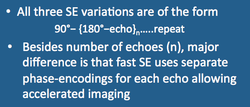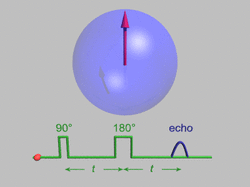Single Echo Spin Echo
|
The simplest form of the spin-echo (SE) pulse sequence consists of 90°-pulse, a 180°-pulse, and then an echo. The time between the middle of the first RF pulse and the peak of the spin echo is called the echo time (TE). The sequence then repeats at time TR, the repetition time.
|
As described in a previous Q&A, the 180°-pulse allows refocusing of nonmoving spins whose phases have been scattered by constant field distortions and inhomogeneities. The pulse does not correct for T1 or true T2 effects due to random processes at the atomic/molecular level. It does not correct for phase shifts of spins that move, flow, diffuse or undergo chemical exchange. But if the spin has dephased simply because it is sitting near a chunk of iron-containing hemosiderin or near some imperfection in the main magnetic field of any cause, the 180°-pulse will correct for that!
|
The animation to the left (borrowed from Wikipedia) shows the steps of SE formation: 1) tipping of spins into the transverse plane by the 90°-pulse; 2) dephasing of these spins by local magnetic field inhomogeneities; 3) flipping of the entire ensemble like a pancake in the transverse plane by the 180°-pulse; and 4) refocusing of spins into a SE at time TE = 2 x t. |
Until the last decade double-echo SE sequences like the one pictured above were a standard technique. The first echo (at short TE) provided "spin-density" contrast while the second echo (at long TE) provided T2-weighted contrast. Today, T2-FLAIR has largely supplanted spin-density-weighted SE images for most applications, so multi-echo SE is only occasionally used.
Fast (Turbo) Spin Echo (FSE)
Multi-echo SE should be distinguished from FSE where multiple 180°-pulses and echoes also follow each 90°-pulse. The simplified FSE pulse-echo timing diagram appears below
Fast (Turbo) Spin Echo (FSE)
Multi-echo SE should be distinguished from FSE where multiple 180°-pulses and echoes also follow each 90°-pulse. The simplified FSE pulse-echo timing diagram appears below
Superficially this appears similar to multi-echo SE, although you may note that the echoes are not uniformly diminishing in size with increasing TE multi-echo SE as expected. The reason the echoes look different is because in FSE different phase-encoding gradients (not shown) are being applied with each 180°-pulse. In single echo and multi-echo SE imaging, the phase-encoding gradient is turned on only once in each TR interval. Depending on the number of echoes, in FSE imaging the phase-encoding may be applied 8, 16, 32 or more times in each TR interval.
Don't worry if you don't understand this right now, as we have not yet reached the section on phase-encoding, k-space, or image creation. Several full Q&A sections will be devoted to each of these topics as well as FSE imaging.
Don't worry if you don't understand this right now, as we have not yet reached the section on phase-encoding, k-space, or image creation. Several full Q&A sections will be devoted to each of these topics as well as FSE imaging.
Advanced Discussion (show/hide)»
No supplementary material yet. Check back soon!
References
Brewer RG, Hahn EL. Atomic memory. Sci Amer 1984:251(6):50-57.
Feinberg DA, Mills CM, Posin JP et al. Multiple spin-echo magnetic resonance imaging. Radiology 1985;155:437-442.
Hahn EL. Spin echoes. Phys Rev 1950;80:580-594.
Hennig J. Echoes - How to generate, recognize, use or avoid them in MR-imaging sequences. Part I: Fundamental and not so fundamental properties of spin echoes. Concepts Magn Reson 1991; 3:125-143.
Jung BA, Weigel M. Spin echo magnetic resonance imaging. J Magn Reson Imaging 2013; 37:805-817. (excellent review of basic concepts)
"Spin Echo". Wikipedia. The Free Encyclopedia.
Brewer RG, Hahn EL. Atomic memory. Sci Amer 1984:251(6):50-57.
Feinberg DA, Mills CM, Posin JP et al. Multiple spin-echo magnetic resonance imaging. Radiology 1985;155:437-442.
Hahn EL. Spin echoes. Phys Rev 1950;80:580-594.
Hennig J. Echoes - How to generate, recognize, use or avoid them in MR-imaging sequences. Part I: Fundamental and not so fundamental properties of spin echoes. Concepts Magn Reson 1991; 3:125-143.
Jung BA, Weigel M. Spin echo magnetic resonance imaging. J Magn Reson Imaging 2013; 37:805-817. (excellent review of basic concepts)
"Spin Echo". Wikipedia. The Free Encyclopedia.




